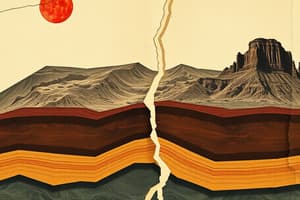Podcast
Questions and Answers
What happens at convergent boundaries?
What happens at convergent boundaries?
- Tectonic plates rotate in opposite directions
- Tectonic plates slide horizontally past each other
- Tectonic plates move apart from each other
- Tectonic plates collide or slide past each other (correct)
What geological feature is formed at convergent boundaries due to one plate sinking beneath the other?
What geological feature is formed at convergent boundaries due to one plate sinking beneath the other?
- Continental drifts
- Mountain ranges (correct)
- Deserts
- Canyons
What type of boundary involves tectonic plates sliding past each other horizontally?
What type of boundary involves tectonic plates sliding past each other horizontally?
- Convergent boundaries
- Transform boundaries (correct)
- Subduction boundaries
- Divergent boundaries
What geological feature is typically associated with transform boundaries?
What geological feature is typically associated with transform boundaries?
Which tectonic plate movement results in the formation of new crust and magma?
Which tectonic plate movement results in the formation of new crust and magma?
Which collision between tectonic plates created the Himalayas?
Which collision between tectonic plates created the Himalayas?
What type of boundary is characterized by earthquakes and relative movement between the North American and Pacific plates?
What type of boundary is characterized by earthquakes and relative movement between the North American and Pacific plates?
Where can transform boundaries primarily be found?
Where can transform boundaries primarily be found?
At divergent boundaries, what process leads to the formation of new oceanic crust?
At divergent boundaries, what process leads to the formation of new oceanic crust?
Which type of boundary is associated with the creation of new landmasses due to the formation of new continental crust?
Which type of boundary is associated with the creation of new landmasses due to the formation of new continental crust?
What geological feature is commonly found at mid-ocean ridges, in addition to the formation of new crust?
What geological feature is commonly found at mid-ocean ridges, in addition to the formation of new crust?
What is a key outcome of the relative movement between tectonic plates at transform boundaries?
What is a key outcome of the relative movement between tectonic plates at transform boundaries?
Study Notes
Tectonic Plate Movements
Tectonic plates are large, interconnected pieces that make up the outer shell of our planet, the lithosphere. These plates are in constant motion due to a phenomenon known as convection currents within Earth's mantle. As they drift, they create various types of boundaries where they interact with one another, leading to the formation of mountains, valleys, and oceans—all while shaping our ever-changing planet.
Convergent Boundaries
At convergent boundaries, two tectonic plates collide or slide past one another. One plate typically sinks beneath the other, forming a subduction zone. This process is called subduction. As the denser plate descends, heat and pressure within the mantle cause it to melt, forming magma. This magma rises, cools, and solidifies, creating new crust and pushing upward to form mountain ranges, such as the Rocky Mountains or the Andes.
Convergent boundaries can also create volcanoes, like the Cascade Range in North America. As the North American plate moves over the subducting Juan de Fuca plate, it causes the crust to compress and melt, resulting in volcanic activity.
In some instances, two plates can collide side by side, creating an orogeny, or a mountain-building event. For example, the Himalayas formed when the Indian plate collided with the Eurasian plate.
Transform Boundaries
At transform boundaries, two tectonic plates slide past one another horizontally. These boundaries are characterized by earthquakes, such as the San Andreas Fault in California. Along this transform boundary, the North American plate moves northwest while the Pacific plate moves northeast. Their relative movement creates faults and leads to seismic activity.
Transform boundaries can also be found at mid-ocean ridges, where plates are moving away from one another. However, these areas are also sites of volcanic activity, where new ocean floor is created from molten lava.
Divergent Boundaries
At divergent boundaries, two tectonic plates move away from one another, causing new crust to be created. This usually happens at mid-ocean ridges, such as the East Pacific Rise. As magma rises from the mantle, it solidifies, forming new oceanic crust.
Mid-ocean ridges are also characterized by hydrothermal vents, where hot water rich in minerals and chemicals is released into the ocean. These vents support unique ecosystems that rely on the chemical energy present.
In some cases, divergent boundaries can also occur on the continental crust, such as the East African Rift. At these boundaries, new continental crust is formed, leading to the creation of new landmasses.
Tectonic plate movements shape our planet and its landscape in profound ways. Understanding these processes provides a window into Earth's history and a glimpse at its future. As we continue to study the interactions between tectonic plates, we can better predict their impact on our planet and its inhabitants.
Studying That Suits You
Use AI to generate personalized quizzes and flashcards to suit your learning preferences.
Description
Test your knowledge on tectonic plate movements, including convergent, divergent, and transform boundaries. Learn about how these geological processes shape our planet's landscape and create features like mountains, valleys, oceans, and volcanoes.




